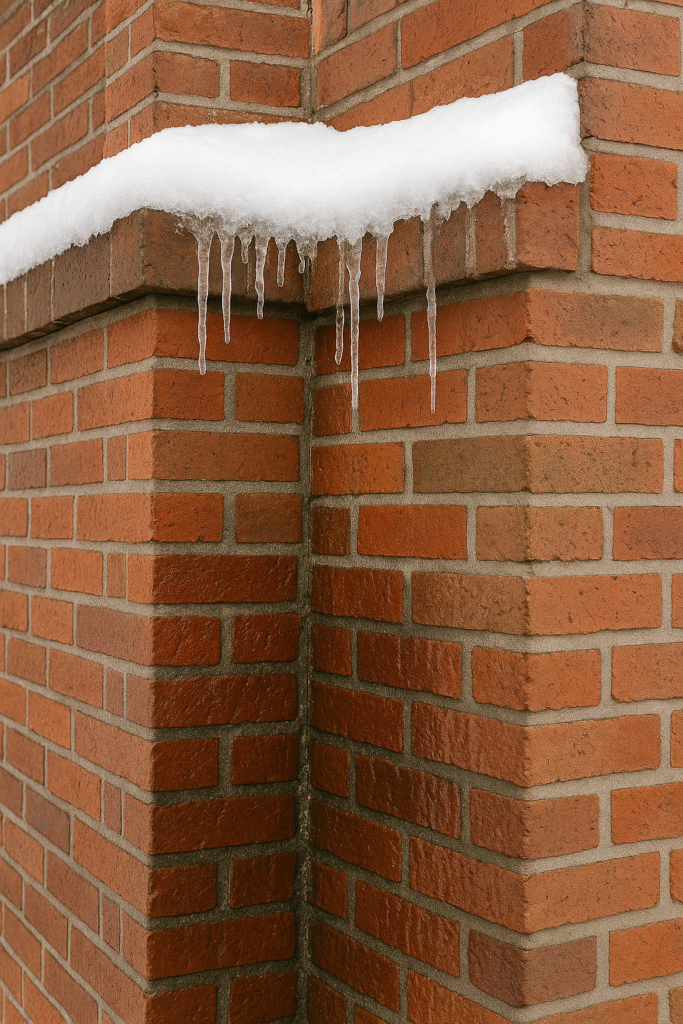What is Freeze-Thaw?
Have you ever noticed how potholes grow larger and more destructive after each wave of cold throughout the winter? This is due to freeze-thaw cycles, and while damage on the roads may slow your commute, these freeze-thaw cycles can negatively impact your building envelope and hamper your facility’s productivity. Water settles into the pores and crevices, and when the temperature drops, the water freezes and expands up to 9%. This widens the crack, only for the temperature to rise and melt the water. This natural back and forth affects regions all over the country on a yearly basis.
Roof Impact
Water is the universal solvent. Whether in liquid, gas or a frozen state, the effects of water exposure are well documented. Roofing systems can experience significant thermal cycling (major temperature swings, sustained heat, sustained cold, etc.), making them more susceptible to the freeze-thaw cycle. Materials in roofs must have low porosity, possess dimensional stability and provide enough tensile strength to withstand movement without experiencing damaging consequences.
With steep slope (water shedding) roofs, ice dams can form and widen areas of concern. Repetitive freeze-thaw cycles can attack vulnerable areas of the low eave where conditions may be modestly insulated. Check out more on how to prevent ice dam formation in our article, “Ice Dam Prevention for Steep Slope Roofs.”
Façade Impact
In a similar manner to roofs or roads, water penetrates masonry and damages façade systems too. If moisture is able to infiltrate the wall system, then the freezing thaw effects can destroy your façade from the inside out. One significant part of a masonry façade is mortar which can deteriorate over the years. As the mortar deteriorates it becomes friable and more porous this allows for moisture to infiltrate the façade system. Other parts of the façade system that deteriorate or fail, allowing moisture penetration, are sealants, flashings and other construction materials. Once moisture enters a façade system the freeze thaw effects can occur causing material to move and shift which could cause for falling material and structural damage.
Another concern façade systems face is the buildup of chlorides, particularly at building entrances. Sodium chloride, the most commonly used deicer, is brought in on people’s shoes and unless dealt with quickly, their presence can erode common façade building materials. This damage in turn allows more moisture to infiltrate the system and make the problem even larger.
Parking Garages
Like façade systems, parking garages are susceptible to both moisture penetration and chloride buildups but to a greater degree. Cars pick up road salt and other de-icing chlorides in the snow ultimately get deposited in the parking garage as the cars dive and park. Unless properly dealt with, this salty slurry seeps into the concrete, allowing the freeze-thaw cycle to attack the interior structure.
Freeze-Thaw Remedial Options
When it comes to battling the yearly freeze-thaw cycle, here are three tips you can use in the future.
Roof Systems
Roofs are designed to withstand snow loads based on historical data from your geographic location and design calculations that include a safety margin. However, sometimes the snow must be removed to prevent negative structural implications. On a low-slope roof, snow removal must be carefully executed. Snow varies in water content, its weight per inch of accumulation will vary, so snow depth is not a good criterion to base snow removal decisions. When in doubt, call a professional snow removal company or building envelope consultant to know if the snow needs to be removed. They’ll have the knowledge to assist in making the best decisions regarding the safety of your roof system.
When talking about mitigation of ice dams, we’re typically dealing with warm air exfiltration which can be managed by addressing thermal shorts. In the case of proper roofing design, we’d be discussing a waterproof medium (ice and water shield underlayment) down on the deck surface. With freeze-thaw remediation through mechanical devices, heat-trace cabling is the best course of action, though it can get expensive.
Façade systems
When it comes to protecting your façade systems from freeze-thaw, the best option is to prevent the moisture penetration in the first place. Pay attention to areas of deterioration and address them immediately. Sealant replacement can be a cost-effective and necessary need as sealants break down and fail. Use high performing exterior sealants for maximum effectiveness. Maintaining elements of the façade, including flashings, mortar, brick and stone units and copings are all ways to mitigate moisture infiltration into the façade system. Also don’t forget to clean and maintain your entrances to minimize the time chlorides have to create damage. Regular maintenance goes a long way to a healthy building envelope.
Parking Garages
The top way to ensure the longevity of your parking garage is to apply a deck coating that prevents water intrusion in the first place. This negates chloride and moisture infiltration and ultimately the effects of corrosion of the embedded reinforcement and the freeze-thaw cycle. Another practical tip is semi-annual cleaning. Wash out all the chloride-riddled sludge that can damage the structure of your garage. Check out “Parking Garage Cleaning: When Did You Last Wash Yours?”
Professional help
If you are unsure of what processes should be taken to combat freeze-thaw in the future or where to start, Technical Assurance can partner with you to alleviate your unique concerns. With almost 30 years of experience, our building envelope consultants are experts who specialize in investigation and assessments of building enclosure failure. Technical Assurance can remediate issues and develop the best course of action to prevent problems from happening in the first place. For more reasons on why utilizing a building envelope consultant is a wise investment, check out our article “7 Reasons to Hire a Building Envelope Consultant.”
Contact Technical Assurance for Assistance Today!
Are your facilities experiencing the freeze-thaw? Contact the Technical Assurance team to set up a consultation and start protecting your investment.

